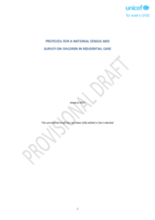A child’s care status impacts his or her health, developmental outcomes and general well-being, both during childhood and later in life. Children outside of a family setting are more likely than their family-based peers to experience abuse, neglect, exploitation, lack of stimulation, poor nutrition and toxic stress, with lifelong physical and psychological repercussions. Moreover, children living in institutional settings are frequently missing from official statistics since reporting for many indicators, particularly those that comprise global monitoring frameworks such as the Sustainable Development Goals (SDGs), rely heavily on data collected through household surveys.
In response to the need for accurate and reliable statistics on children in residential care, UNICEF has developed the first-ever comprehensive package to collect data on children living in residential care settings. It is comprised of a protocol that outlines the recommended steps for gathering the data; 12 data collection tools; and a comprehensive implementation package covering all aspects from design to dissemination of the findings.
These objectives are achieved through two phases of data collection: Phase One is the census of facilities and enumeration of children and Phase Two is the follow-up survey on selected measures of well-being for a representative sample of children living in residential care.
This protocol for data collection on children living in residential care facilities (RCFs) aims to provide governments with clear guidance on recommended actions and steps for undertaking a census to map and enumerate such facilities and the children living in them.
Additional resources:
Questionnaires and tools for Phase One:
Questionnaires and tools for Phase Two:

